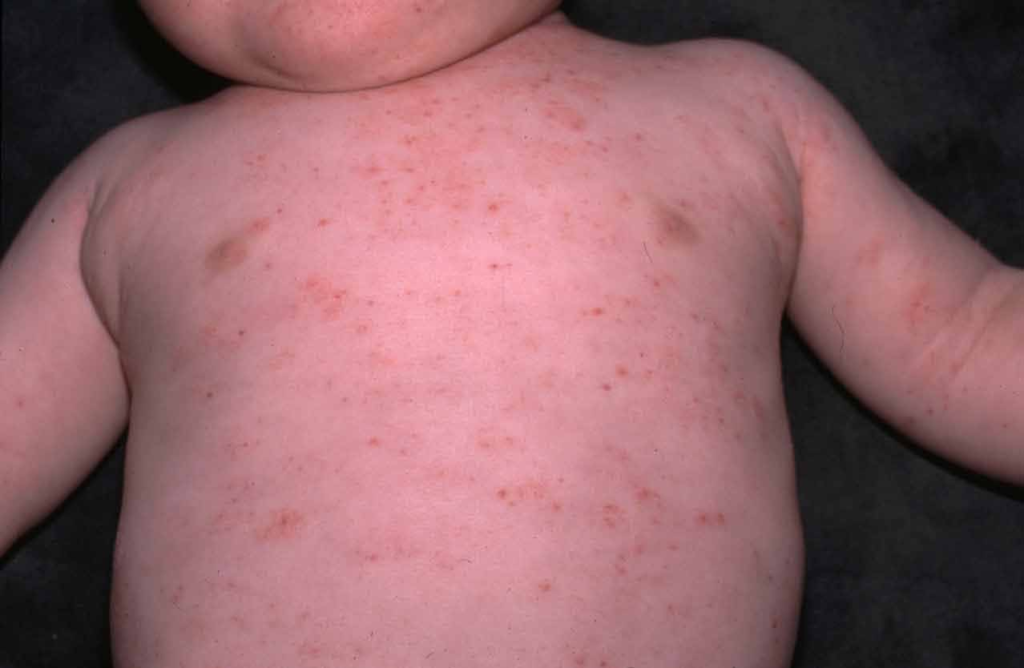Snapshot – Wiskott-Aldrich Syndrome

- An 8-year-old boy is brought to his pediatrician for easy bruising. On physical exam, he is found with petechiae and purpura in multiple areas over his body, as well as bruises over his arms. Eczematous patches are also found on his flexural surfaces. Laboratory results reveal thrombocytopenia to 30,000/mm3. Further questioning reveals a past medical history of multiple hospital stays due to pneumonia and otitis media infections as well as recurrent epistaxis.
Introduction
- Primary immunodeficiency disorder of B and T cells
- Pathogenesis
- mutation in WAS gene encoding Wiskott-Aldrich syndrome protein (WASp)
- impaired actin cytoskeleton
- results in defective T cell signalling and interactions with APCs
- also impairs phagocytosis and chemotaxis
- loss of cellular and humoral response
- mutation in WAS gene encoding Wiskott-Aldrich syndrome protein (WASp)
- Genetics
- X-linked recessive
- To remember (WATER)
- Recurrent infections
Presentation
- Symptoms/physical exam
- recurrent bacterial, viral, fungal infections
- frequency increases with age
- bacterial agents: Streptococcus pneumonia, Haemophilus influenza, Neisseria meningitides
- viral agents: varicella and CMV
- fungal infections: Candida albicans
- thrombocytopenia
- recurrent bleeding, especially in first days of life
- petechiae
- purpura
- easy bruising
- hematemesis
- epistaxis
- hematuria
- recurrent bleeding, especially in first days of life
- chronic eczema
- recurrent bacterial, viral, fungal infections
- hepatosplenomegaly common
Evaluation
- Serologies
- ↓ number of T and B cells
- ↓ to normal IgG, IgM
- ↑ IgE, IgA
- Labs
- thrombocytopenia
- usually 20,000/mm3 – 50,000/mm3
- thrombocytopenia
- Gene sequence analysis of WAS essential to confirm diagnosis
Differential Diagnosis
Treatment
- Antibiotics
- IVIG
- Hematopoietic stem cell transplantation
- only curative treatment
Prognosis, Prevention, and Complications
- Prognosis
- reduced life expectancy (see complications below)
- bleeding is main cause of death
- Complications
- increased risk of
- autoimmune diseases
- malignancies (lymphomas, leukemias), usually fatal
- infections
- complications may lead to early death
- chronic eczema
- superinfection
- increased risk of
Wiskott-Aldrich Syndrome (WAS) is a rare X-linked recessive primary immunodeficiency disorder characterized by a triad of symptoms: eczema, recurrent infections, and thrombocytopenia (low platelet count). This condition results from mutations in the WAS gene, leading to dysfunctional immune cells and an increased susceptibility to infections, autoimmune disorders, and bleeding disorders. Understanding Wiskott-Aldrich Syndrome is crucial for medical professionals, particularly those in immunology, pediatrics, and hematology. This article provides a comprehensive overview of Wiskott-Aldrich Syndrome, including its types, functions, related studies, treatment considerations, and clinical significance.
Types of Wiskott-Aldrich Syndrome:
There are three recognized types of Wiskott-Aldrich Syndrome:
- Classic WAS: This is the most common and severe form of WAS, characterized by the full triad of symptoms: eczema, recurrent infections, and thrombocytopenia.
- X-Linked Thrombocytopenia (XLT): XLT is a milder form of WAS where patients experience primarily thrombocytopenia and a reduced risk of severe eczema and infections.
- Intermittent Thrombocytopenia (ITP): ITP is an even milder variant where patients experience transient and mild thrombocytopenia without significant eczema or infections.
Function of the WAS Gene:
The WAS gene encodes the Wiskott-Aldrich Syndrome protein (WASP), which plays a critical role in cytoskeletal organization within immune cells, particularly lymphocytes and platelets. WASP is essential for cell motility, adhesion, and signal transduction.
Clinical Manifestations:
Wiskott-Aldrich Syndrome is characterized by a range of clinical features:
- Eczema: Patients often develop severe eczema (atopic dermatitis) early in life.
- Recurrent Infections: Due to compromised immune function, individuals with WAS are highly susceptible to bacterial, viral, and fungal infections, including pneumonia and sepsis.
- Thrombocytopenia: Low platelet counts can lead to spontaneous bleeding, bruising, and petechiae. Severe cases can result in life-threatening hemorrhages.
- Autoimmune Disorders: WAS patients are at increased risk of developing autoimmune conditions such as autoimmune hemolytic anemia and vasculitis.
Wiskott-Aldrich Syndrome Studies:
- Genetic Studies: Research focuses on identifying mutations in the WAS gene and understanding how they impact immune cell function.
- Immunological Mechanisms: Studies investigate the underlying immunological mechanisms responsible for the clinical manifestations of WAS.
Clinical Significance:
- Immunodeficiency: WAS patients have compromised immune function, making them highly susceptible to infections.
- Bleeding Disorders: Thrombocytopenia can lead to life-threatening bleeding episodes.
Future Directions:
- Gene Therapy: Research into gene therapy approaches for WAS aims to correct the genetic mutations and restore immune cell function.
- Targeted Therapies: Investigational therapies focus on improving specific aspects of immune cell function in WAS patients.
Conclusion:
Wiskott-Aldrich Syndrome is a rare X-linked recessive primary immunodeficiency disorder characterized by a triad of symptoms: eczema, recurrent infections, and thrombocytopenia. Mutations in the WAS gene lead to dysfunctional immune cells and an increased susceptibility to infections, autoimmune disorders, and bleeding disorders. WAS can manifest in various forms, from classic WAS with the full triad of symptoms to milder variants like XLT and ITP. Research in genetics and immunological mechanisms enhances our understanding of this complex disorder.
Check out Ultimate USMLE Step 1 Study Notes.



